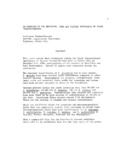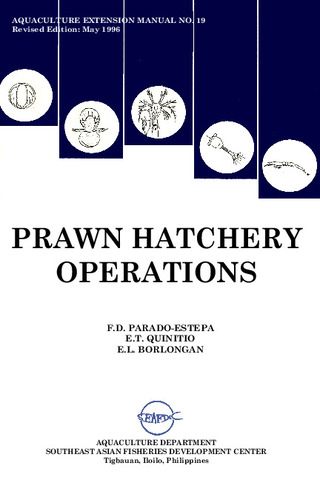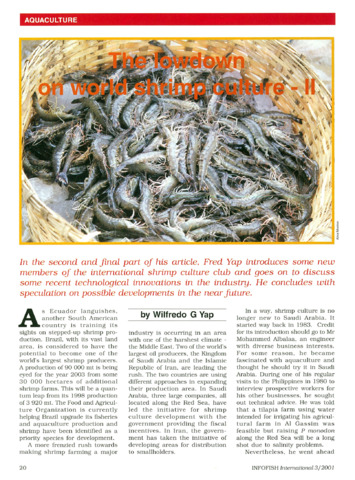| dc.contributor.author | Vogt, G. | |
| dc.contributor.author | Quinitio, Emilia T. | |
| dc.contributor.author | Pascual, Felicitas P. | |
| dc.contributor.editor | De Pauw, Niels | |
| dc.contributor.editor | Jaspers, Edmonde | |
| dc.contributor.editor | Ackefors, Hans | |
| dc.contributor.editor | Wilkins, Noël | |
| dc.date.accessioned | 2011-06-22T09:35:16Z | |
| dc.date.available | 2011-06-22T09:35:16Z | |
| dc.date.issued | 1989 | |
| dc.identifier.citation | Vogt, G., Quinitio, E. T., & Pascual, F. P. (1989). Interaction of the midgut gland and the ovary in vitellogenesis and consequences for the breeding success: a comparison of unablated and ablated spawners of Penaeus monodon. In N. De Pauw, E. Jaspers, H. Ackefors, & N. Wilkins (Eds.), Aquaculture - a biotechnology in progress. Proceedings of the International Conference Aquaculture Europe ’87, Amsterdam, The Netherlands, June 2-5, 1987 (Vol. 1, pp. 581–592). Bredene, Belgium: European Aquaculture Society. | en |
| dc.identifier.isbn | 9071625036 | |
| dc.identifier.uri | http://hdl.handle.net/10862/322 | |
| dc.description.abstract | The midgut glands and ovaries of unablated and ablated females of Penaeus monodon were examined before and after spawning by light and electron microscopy to elucidate the role of the midgut gland during vitellogenesis. In addition, the larvae of both were divided into fed and starved groups and the mortalities were recorded up to stage postlarva 5 in order to compare the quality of the offspring from unablated and ablated spawners. Although a limited number of spawners was used in this preliminary study, a close interaction of the midgut gland and the ovary during vitellogenesis is evident. The influence of eyestalk ablation on the breeding success is discussed and hypothetically correlated to endocrinology. In late vitellogenesis, the resorptive cells of the midgut gland of an unablated female exhibited specific ultrastructural characteristics such as whirls of rough endoplasmic reticulum, conspicuous Golgi bodies and highly active smooth endoplasmic reticulum. The ablate these features only in moderate development. After spawning, the normal structures of the midgut gland cells were restored to a large extent. In the ovary of the unablated female before spawning, mature oocytes were dominant. After spawning, the ovary of the unablated female contained only immature oocytes. In contrast, all stages of maturation could be found in the ablated female 2h after spawning. The hatching rate was much lower in the ablated female. Up to stage postlarva 5, however, fed larvae from the ablated and unablated spawners had the same mortality rates. Starved zoea 1 from both types of spawners could not reach the next moulting stage without feeding. This indicates the urgent necessity of good feed at the very beginning of larval development. When the larvae were fed until moulting to mysis and then starved during mysis stage, the offspring of the ablated spawner died earlier than that of the unablated female. Only a very few starved larvae reached the postlarval stage. In any case, starvation led to an extension of the various larval stages and substages. | en |
| dc.language.iso | en | en |
| dc.publisher | European Aquaculture Society | en |
| dc.subject | Decapoda | en |
| dc.subject | Penaeus monodon | en |
| dc.subject.lcc | VF SP 0113 | |
| dc.title | Interaction of the midgut gland and the ovary in vitellogenesis and consequences for the breeding success: a comparison of unablated and ablated spawners of Penaeus monodon | en |
| dc.type | Conference paper | en |
| dc.citation.volume | 1 | |
| dc.citation.spage | 581 | |
| dc.citation.epage | 592 | |
| dc.subject.asfa | Midgut gland | en |
| dc.subject.asfa | ovaries | en |
| dc.subject.asfa | vitellogenesis | en |
| dc.subject.asfa | Larval development | en |
| dc.citation.conferenceTitle | Aquaculture - A Biotechnology in Progress. Proceedings of the International Conference Aquaculture Europe '87, Amsterdam, The Netherlands, June 2-5, 1987 | en |
| dc.subject.scientificName | Penaeus monodon | |



